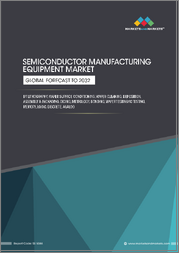
|
시장보고서
상품코드
1803878
반도체 웨이퍼 분류 시스템 시장 : 장비 유형, 분류 기술, 카테고리, 최종사용자별 - 세계 예측(2025-2030년)Semiconductor Wafer Sorting Systems Market by Equipment Type, Sorting Technology, Category, End User - Global Forecast 2025-2030 |
||||||
반도체 웨이퍼 분류 시스템 시장은 2024년에 13억 5,000만 달러로 평가되었으며, 2025년에는 14억 7,000만 달러, CAGR 8.34%로 성장하여 2030년에는 21억 9,000만 달러에 달할 것으로 예측됩니다.
| 주요 시장 통계 | |
|---|---|
| 기준 연도 2024년 | 13억 5,000만 달러 |
| 추정 연도 2025년 | 14억 7,000만 달러 |
| 예측 연도 2030년 | 21억 9,000만 달러 |
| CAGR(%) | 8.34% |
반도체 제조 가치사슬 전반의 효율성과 품질 향상에 있어 첨단 웨이퍼 분류 시스템의 중요한 역할에 대해 알아보겠습니다.
반도체 산업은 소형화 및 성능 향상을 끊임없이 추구하면서 웨이퍼 분류 시스템을 제조의 최전선으로 끌어올렸습니다. 웨이퍼가 점점 더 복잡해짐에 따라 고정밀, 고처리량 분류 기능의 필요성이 그 어느 때보다 높아지고 있습니다. 이 소개에서는 웨이퍼 분류가 디바이스의 신뢰성을 보장하고, 수율을 극대화하며, 비용 효율성과 지속가능성이라는 업계 전반의 목표에 부합하기 위해 웨이퍼 분류가 수행하는 매우 중요한 역할에 대해 자세히 알아봅니다.
반도체 수율, 처리량, 운영 우수성을 재구축하는 웨이퍼 분류 기술의 획기적인 변화를 살펴봅니다.
지난 10년간 웨이퍼 분류 기술은 큰 변화를 겪었습니다. 이는 더 높은 처리량과 그 어느 때보다 까다로워진 결함 검출 임계값과의 조화를 이루기 위한 요구 때문입니다. 초기 세대의 웨이퍼 분류기는 기계적 이송과 기본적인 광학 검사에 중점을 두었지만, 오늘날의 플랫폼은 정전기 처리, 레이저 기반 측정 및 고급 이미지 분석을 통합하여 전례 없는 정밀도와 속도를 달성했습니다.
미국의 새로운 관세 정책이 웨이퍼 분류 장비 공급망 및 제조업체 전략에 미치는 누적 영향 평가
반도체 장비 수입에 대한 새로운 관세 조치의 제정은 웨이퍼 분류 장비 공급업체와 최종사용자에게 여러 가지 문제를 야기했습니다. 이러한 정책의 의도는 국내 제조를 강화하는 것이지만, 예상치 못한 결과로 공급망 전체의 비용 변동이 증가하고 있습니다. 장비 제조업체들은 부품 조달을 재검토하고, 수입 관세의 영향을 줄이기 위해 지역 공급업체와 새로운 파트너십을 구축하고, 관세 면제를 활용하기 위해 생산 기지를 재편하고 있습니다.
웨이퍼 분류에서 장비 유형, 분류 기술, 카테고리 차이, 최종사용자 용도에 따른 전략적 세분화 관점을 밝힙니다.
웨이퍼 자동 처리 플랫폼, 웨이퍼 검사 시스템, 웨이퍼 분류기는 장비의 종류에 따라 고유한 성능 특성과 비즈니스 사례를 보여주고 있습니다. 웨이퍼 자동화 시스템은 대량 생산 공장 내 원활한 통합에 특화되어 있으며, 웨이퍼 핸들러는 섬세한 기판을 보호하기 위해 부드러운 이송 메커니즘을 우선시합니다. 검사 시스템은 결함 분석에 중점을 두고, 전용 웨이퍼 분류기는 엄격한 품질 보증을 위한 특별한 프로토콜을 제공합니다.
아메리카, 유럽, 중동 및 아프리카, 아시아태평양 시장에 걸친 웨이퍼 분류 분야의 지역적 역학에 대한 이해
웨이퍼 분류 시스템에 대한 수요는 제조 생태계와 정책 프레임워크의 차이에 따라 아메리카, 유럽, 중동 및 아프리카, 아시아태평양별로 크게 다릅니다. 아메리카에서는 국내 반도체에 대한 노력이 다시 살아나고 있으며, 자동차 및 방위 산업용 생산능력 증대에 중점을 둔 첨단 소팅 플랫폼에 대한 투자에 박차를 가하고 있습니다. 이 지역은 기술 혁신과 품질에 중점을 두고 있기 때문에 고정밀 레이저 선별과 정전기 선별 기술의 채택이 가속화되고 있습니다.
반도체 웨이퍼 소팅 장비 생태계의 경쟁 전략과 성장 촉진요인에 대한 자료입니다.
웨이퍼 분류 장비 시장의 선두주자는 탄탄한 R&D 투자와 전략적 제휴의 조합을 통해 두드러진 존재감을 드러내고 있습니다. 이 선구적인 공급업체는 광학, 정전기 처리 및 로봇 공학의 핵심 전문 지식을 활용하여 탁월한 정확도를 제공하는 차세대 분류기를 개발하고 있습니다. 이러한 기존 기업들은 통합된 서비스 네트워크를 통해 경쟁 우위를 유지하고, 복잡한 제조 환경에 대한 신속한 배포와 지속적인 지원을 통해 경쟁 우위를 유지하고 있습니다.
실용적인 실행 계획과 혁신 로드맵을 수립하여 업계 리더들이 운영의 강인함과 경쟁 우위를 강화할 수 있도록 안내합니다.
업계 리더들은 웨이퍼 분류 플랫폼에 머신러닝 알고리즘을 통합하여 결함 분류 정확도를 높이고 오탐지를 줄이는 것을 우선순위로 삼아야 합니다. 적응형 분석을 통합함으로써 장비 공급업체는 다운타임을 최소화하고 시스템 수명주기를 연장하는 예지보전 기능을 제공할 수 있습니다. 또한, 자동화, 검사 및 선별 서브시스템 간의 데이터 인터페이스를 표준화함으로써 원활한 상호운용성을 촉진하고, 보다 광범위한 공장 자동화 제품군으로의 통합을 단순화합니다.
반도체 웨이퍼 분류 시스템 분석을 촉진하는 인사이트를 뒷받침하는 엄격한 조사 방법론과 분석 프레임워크에 대한 자세한 내용
이 조사 방법은 독자적인 1차 인터뷰, 광범위한 2차 조사, 고급 데이터 분석을 결합한 종합적인 방법을 채택하고 있습니다. 장비 제조업체, 파운드리 경영진, 기술 전문가들과의 심층적인 논의를 통해 수집된 주요 인사이트는 새로운 분류 기술, 운영상의 과제, 전략적 우선순위에 대한 생생한 관점을 제공합니다.
진화하는 반도체 웨이퍼 분류 환경을 자신 있게 탐색할 수 있도록 주요 지식과 전략적 임팩트를 통합합니다.
반도체 웨이퍼 분류 부문은 기술 혁신에 힘입어 진화하는 무역 정책에 따라 변화하는 가운데, 매우 중요한 기로에 서 있습니다. 정전기 및 레이저 분류의 비약적인 발전은 모듈식 자동화 플랫폼과 결합하여 처리량과 정확도를 전례 없는 수준으로 끌어올렸습니다. 동시에, 지역 제조 이니셔티브와 관세에 대한 고려는 공급망 전략을 재정의하고 민첩한 적응의 필요성을 강조하고 있습니다.
목차
제1장 서문
제2장 조사 방법
제3장 주요 요약
제4장 시장 개요
제5장 시장 역학
제6장 시장 인사이트
- Porter's Five Forces 분석
- PESTEL 분석
제7장 미국 관세의 누적 영향 2025
제8장 반도체 웨이퍼 분류 시스템 시장 : 장비 유형별
- 웨이퍼 자동화 시스템
- 웨이퍼 핸들러
- 웨이퍼 검사 시스템
- 웨이퍼 소터
제9장 반도체 웨이퍼 분류 시스템 시장 : 분류 기술별
- 정전기
- 레이저
- 기계
- 광학
제10장 반도체 웨이퍼 분류 시스템 시장 : 카테고리별
- 배치 웨이퍼 소터
- 싱글 웨이퍼 소터
제11장 반도체 웨이퍼 분류 시스템 시장 : 최종사용자별
- 파운드리
- 통합 디바이스 제조업체(IDM)
- 아웃소싱 반도체 조립·테스트(OSAT) 기업
- 연구기관
제12장 아메리카의 반도체 웨이퍼 분류 시스템 시장
- 미국
- 캐나다
- 멕시코
- 브라질
- 아르헨티나
제13장 유럽, 중동 및 아프리카의 반도체 웨이퍼 분류 시스템 시장
- 영국
- 독일
- 프랑스
- 러시아
- 이탈리아
- 스페인
- 아랍에미리트
- 사우디아라비아
- 남아프리카공화국
- 덴마크
- 네덜란드
- 카타르
- 핀란드
- 스웨덴
- 나이지리아
- 이집트
- 튀르키예
- 이스라엘
- 노르웨이
- 폴란드
- 스위스
제14장 아시아태평양의 반도체 웨이퍼 분류 시스템 시장
- 중국
- 인도
- 일본
- 호주
- 한국
- 인도네시아
- 태국
- 필리핀
- 말레이시아
- 싱가포르
- 베트남
- 대만
제15장 경쟁 구도
- 시장 점유율 분석, 2024
- FPNV 포지셔닝 매트릭스, 2024
- 경쟁 분석
- Teradyne, Inc.
- Advantest Corporation
- EMU Technologies Ltd.
- C&D Semiconductor Services, Inc.
- FormFactor, Inc.
- Cohu, Inc.
- Jabil Inc.
- QES GROUP BERHAD
- Ficontec GmbH
- SPEA S.p.A.
- SEICA S.p.A.
- GOPEL electronic GmbH
- Tokyo Seimitsu Co., Ltd
- Mechatronic Systemtechnik GmbH
- Microtronic, Inc.
- Canon Machinery Inc.
- InnoLas Semiconductor GmbH
- Fortrend Technology Co.,Ltd.
- Genmark Automation Inc.
- Cencorp(Zhuhai) Industrial Technology Co., Ltd.
제16장 리서치 AI
제17장 리서치 통계
제18장 리서치 컨택트
제19장 리서치 기사
제20장 부록
KSM 25.09.10The Semiconductor Wafer Sorting Systems Market was valued at USD 1.35 billion in 2024 and is projected to grow to USD 1.47 billion in 2025, with a CAGR of 8.34%, reaching USD 2.19 billion by 2030.
| KEY MARKET STATISTICS | |
|---|---|
| Base Year [2024] | USD 1.35 billion |
| Estimated Year [2025] | USD 1.47 billion |
| Forecast Year [2030] | USD 2.19 billion |
| CAGR (%) | 8.34% |
Unveiling the Critical Role of Advanced Wafer Sorting Systems in Driving Efficiency and Quality Across the Semiconductor Manufacturing Value Chain
The semiconductor industry's relentless pursuit of miniaturization and performance enhancement has brought wafer sorting systems to the forefront of manufacturing excellence. As wafers become increasingly complex, the need for precise, high-throughput sorting capabilities has never been more critical. This introduction delves into the pivotal role that wafer sorting plays in ensuring device reliability, maximizing yield, and aligning with industry-wide objectives for cost-effectiveness and sustainability.
Modern wafer sorting equipment is designed to address a spectrum of requirements, from automated handling to defect detection. Innovations in mechanical design and sensor integration have enhanced throughput, while advanced sorting algorithms and software interfaces facilitate real-time decision-making. In turn, these capabilities empower manufacturers to identify and segregate wafers that meet stringent quality standards, minimizing downstream risks and optimizing overall production efficiency.
Looking ahead, the convergence of machine learning, robotics, and adaptive control systems promises to redefine the benchmarks for wafer sorting. Emerging use cases in electric vehicle power electronics, 5G communications, and artificial intelligence hardware further underscore the strategic importance of this technology. With that context established, the subsequent section explores the transformative shifts redefining the wafer sorting landscape, elucidating how recent breakthroughs are reshaping competitive dynamics and operational paradigms.
Exploring Breakthrough Transformations in Wafer Sorting Technology That Are Reshaping Semiconductor Yield, Throughput, and Operational Excellence
Over the past decade, wafer sorting technology has undergone a profound metamorphosis, driven by the imperative to harmonize higher throughput with ever-tighter defect detection thresholds. Early generations of wafer sorters emphasized mechanical conveyance and basic optical inspection, but today's platforms integrate electrostatic handling, laser-based metrology, and sophisticated image analysis to deliver unprecedented accuracy and speed.
The integration of electrostatic sorting mechanisms has facilitated damage-free wafer transfer, thereby preserving the integrity of ultra-thin and fragile substrates. Concurrently, laser-based wafer inspection systems have achieved sub-micron resolution, enabling the detection of surface and sub-surface anomalies that would otherwise escape detection. These advancements have been further complemented by closed-loop feedback systems, which leverage real-time data analytics to adjust sorting parameters dynamically, ensuring consistent performance across highly variable wafer batches.
In parallel, manufacturers are investing in modular automation platforms that streamline changeover between sorting technologies, enhancing operational resilience. The shift toward optical and mechanical hybrid solutions has unlocked new possibilities for customization, allowing end users to tailor sorting protocols to specific device architectures. As a result, wafer producers can rapidly adapt to evolving product roadmaps without compromising throughput. Transitioning from these technological milestones, the next section examines the cumulative impact of United States tariff policies on global wafer sorting supply chains and strategic sourcing decisions.
Assessing the Cumulative Implications of Emerging United States Tariff Policies for Wafer Sorting Equipment Supply Chains and Manufacturer Strategies
The enactment of new tariff measures on semiconductor equipment imports has introduced a multifaceted challenge for wafer sorting system suppliers and end users. While the intent of these policies is to bolster domestic manufacturing, the unintended consequence has been an increase in cost volatility across the supply chain. Equipment manufacturers are reassessing component sourcing, forging new partnerships with regional suppliers to mitigate exposure to import duties, and restructuring production footprints to leverage tariff exemptions.
In response, many leading wafer sorting providers have accelerated efforts to localize subassembly production, shifting critical processes closer to final equipment assembly. This approach not only reduces duty burdens but also enhances supply chain agility, enabling faster response times for customization orders. Strategic collaboration with foundries and IDMs has also intensified, as these end users work in concert with equipment suppliers to co-invest in regional test and measurement facilities that comply with tariff guidelines.
Moreover, companies are exploring hedging strategies and negotiating long-term agreements that incorporate tariff pass-through mechanisms, safeguarding against sudden cost escalations. Despite these adaptations, the complexity of global trade compliance and shifting regulatory frameworks continues to represent a strategic risk. Building on this discussion, the following section offers in-depth segmentation insights, illuminating how equipment type, sorting technology, category, and end user variables intersect to shape investment priorities.
Revealing Strategic Segmentation Perspectives Across Equipment Types, Sorting Technologies, Category Differences, and End User Applications in Wafer Sorting
When viewed through the lens of equipment type, automated wafer handling platforms, wafer inspection systems, and wafer sorters demonstrate unique performance attributes and business cases. Wafer automation systems excel at seamless integration within high-volume fabs, whereas wafer handlers prioritize gentle transfer mechanisms to protect delicate substrates. Inspection systems focus on defect analysis, and dedicated wafer sorters offer specialized protocols for rigorous quality assurance.
Sorting technology further differentiates market trajectories. Electrostatic methods provide non-contact handling ideal for ultra-thin wafers, while laser-based sorting enables precision defect mapping at near-atomic resolutions. Mechanical technologies deliver robust handling, and optical sorting leverages advanced vision systems to detect surface and pattern anomalies. Each technology's suitability depends on device complexity and throughput targets.
Category segmentation highlights the operational trade-offs between batch wafer sorters and single wafer sorters. Batch systems offer economies of scale but may lack the flexibility required for mixed-device production, whereas single wafer sorters deliver granular control and rapid changeover capabilities suitable for prototyping and low-volume specialty applications.
End user segmentation underscores diverse adoption drivers. Foundries prioritize throughput and reliability to service high-volume clients, while integrated device manufacturers balance cost and customization. OSAT firms leverage sorting systems to validate assembly quality, and research institutions adopt flexible platforms to accelerate experimental workflows. With these segmentation dynamics in focus, the subsequent section delves into regional insights, revealing geographic variations in demand and technology uptake.
Uncovering Regional Dynamics in the Wafer Sorting Arena Spanning the Americas, Europe Middle East and Africa, and Asia Pacific Market Environments
Demand for wafer sorting systems varies significantly across the Americas, EMEA, and Asia Pacific regions, driven by distinct manufacturing ecosystems and policy frameworks. In the Americas, a resurgence of domestic semiconductor initiatives has spurred investment in advanced sorting platforms, with a focus on bolstering production capacities for automotive and defense applications. This region's strong emphasis on innovation and quality has accelerated the adoption of high-precision laser and electrostatic sorting technologies.
Meanwhile, Europe Middle East and Africa presents a dynamic environment where advanced manufacturing hubs coexist with emerging markets. Key economies in this region are nurturing local foundries and research centers, prompting equipment providers to offer modular, scalable solutions that cater to both high-volume production and exploratory research. Regulatory support for industry digitization has further driven integration of data analytics and Industry 4.0 capabilities within wafer sorting deployments.
Asia Pacific remains the epicenter of wafer fabrication, underpinned by robust supply chains and substantial public-private investments. Major contract manufacturers and IDMs have demonstrated a sustained appetite for both batch and single wafer sorters, leveraging optical and mechanical sorting innovations to meet rigorous quality standards. Rapid technological diffusion across China, Taiwan, South Korea, and Japan has highlighted the strategic importance of regional partnerships, while emerging fabs in Southeast Asia are increasingly adopting automation to enhance competitiveness.
Building on these regional trends, the next section examines leading and emerging players, spotlighting the competitive strategies shaping the wafer sorting equipment ecosystem.
Illuminating Competitive Strategies and Growth Drivers Shaping Leading and Emerging Players in the Semiconductor Wafer Sorting Equipment Ecosystem
Market leaders in wafer sorting equipment have distinguished themselves through a combination of robust R&D investments and strategic collaborations. Pioneering suppliers have leveraged core expertise in optics, electrostatic handling, and robotics to develop next-generation sorters that deliver unparalleled precision. These incumbents maintain competitive advantages through integrated service networks, ensuring rapid deployment and ongoing support for complex manufacturing environments.
At the same time, emerging players are capturing attention by introducing disruptive innovations. These companies often originate from adjacent sectors such as photonics or automation and apply novel materials and sensor fusion techniques to wafer sorting challenges. Their lean organizational structures enable agile product development cycles, resulting in customizable platforms that cater to niche applications and fast-evolving process nodes.
Strategic partnerships between equipment vendors and end users have become a cornerstone of competitive differentiation. Collaborative development agreements allow fabs and OSAT firms to co-design sorting solutions that align with proprietary process flows, unlocking performance gains and reducing cycle times. Additionally, joint ventures with research institutions facilitate rapid prototyping of emerging technologies, accelerating time to market for advanced sorting methodologies.
These competitive strategies underscore the importance of ecosystem orchestration, where alliances across the value chain drive innovation and shared risk mitigation. With this competitive landscape in mind, the subsequent section presents actionable recommendations to guide industry leaders toward sustained growth.
Formulating Pragmatic Action Plans and Innovation Roadmaps to Guide Industry Leaders Toward Enhanced Operational Resilience and Competitive Advantage
Industry leaders should prioritize the integration of machine learning algorithms within wafer sorting platforms to enhance defect classification accuracy and reduce false positives. By embedding adaptive analytics, equipment suppliers can offer predictive maintenance capabilities that minimize downtime and extend system lifecycles. Furthermore, standardizing data interfaces across automation, inspection, and sorting subsystems will facilitate seamless interoperability and simplify integration into broader factory automation suites.
In parallel, forging strategic alliances with regional component suppliers can mitigate supply chain uncertainties and tariff impacts. Co-locating subassembly production near key manufacturing hubs not only reduces logistics costs but also accelerates responsiveness to changing demand profiles. Collaborative training programs with foundries and OSAT firms can ensure that operators maintain proficiency as sorting protocols evolve toward more complex device architectures.
Additionally, investing in modular system designs will empower customers to reconfigure equipment rapidly in response to shifting product mixes. This flexibility is especially critical in mixed-technology fabs where time-to-market pressures demand agile manufacturing solutions. Finally, establishing multi-tier service agreements that combine remote diagnostics with on-site expertise can enhance customer satisfaction and drive long-term revenue streams through preventative maintenance contracts.
Implementing these recommendations will enable industry leaders to strengthen operational resilience, accelerate innovation cycles, and secure a competitive edge as the semiconductor wafer sorting landscape continues to evolve.
Detailing Rigorous Research Methodology and Analytical Frameworks Underpinning the Insights Driving the Semiconductor Wafer Sorting Systems Analysis
This research employs a comprehensive methodology that combines proprietary primary interviews, extensive secondary research, and advanced data analytics to underpin its conclusions. Primary insights were gathered through in-depth discussions with equipment manufacturers, foundry executives, and technology experts, providing firsthand perspectives on emerging sorting technologies, operational challenges, and strategic priorities.
Secondary research encompassed an exhaustive review of industry publications, patent filings, technical white papers, and regulatory documents. This approach ensured that historical trends, technology evolution pathways, and policy developments were meticulously analyzed. Further, thematic analysis techniques were applied to synthesize qualitative data, while quantitative frameworks were used to assess technology adoption patterns and supply chain dynamics without relying on market sizing projections.
Analytical frameworks such as technology readiness level assessments and value chain mapping were leveraged to evaluate each segmentation dimension. Scenario analyses examined the implications of tariff changes and regional policy shifts, integrating expert inputs to validate assumptions. Finally, cross-validation of findings through triangulation ensured the reliability and accuracy of strategic insights, enabling stakeholders to make well-informed decisions in the rapidly evolving wafer sorting domain.
Synthesizing Key Findings and Strategic Imperatives to Navigate the Evolving Semiconductor Wafer Sorting Landscape with Confidence
The semiconductor wafer sorting sector is at a pivotal juncture, propelled by technological innovation and reshaped by evolving trade policies. Breakthroughs in electrostatic and laser-based sorting, coupled with modular automation platforms, are elevating throughput and precision to unprecedented levels. Simultaneously, regional manufacturing initiatives and tariff considerations are redefining supply chain strategies, underscoring the need for agile adaptation.
Segmentation analysis reveals that equipment type, sorting technology, operational category, and end user requirements each drive distinct investment trajectories, necessitating tailored solutions that balance performance with flexibility. Regional insights further highlight divergent priorities: the Americas' focus on domestic capacity expansion, EMEA's emphasis on modular scalability, and Asia Pacific's rapid technology diffusion across high-volume fabs.
Competitive dynamics are characterized by collaboration between established incumbents and nimble challengers, with partnerships and co-development agreements serving as catalysts for innovation. To navigate this complex landscape, industry leaders must adopt data-driven approaches, foster ecosystem alliances, and embrace modular, software-defined architectures.
In conclusion, the strategic interplay of technological advancement, policy evolution, and competitive orchestration will shape the future of wafer sorting systems. Stakeholders who align their investments with these imperatives will be well-positioned to capture emerging opportunities and maintain leadership in semiconductor manufacturing excellence.
Table of Contents
1. Preface
- 1.1. Objectives of the Study
- 1.2. Market Segmentation & Coverage
- 1.3. Years Considered for the Study
- 1.4. Currency & Pricing
- 1.5. Language
- 1.6. Stakeholders
2. Research Methodology
- 2.1. Define: Research Objective
- 2.2. Determine: Research Design
- 2.3. Prepare: Research Instrument
- 2.4. Collect: Data Source
- 2.5. Analyze: Data Interpretation
- 2.6. Formulate: Data Verification
- 2.7. Publish: Research Report
- 2.8. Repeat: Report Update
3. Executive Summary
4. Market Overview
- 4.1. Introduction
- 4.2. Market Sizing & Forecasting
5. Market Dynamics
- 5.1. Increasing adoption of AI-driven inline wafer sorting systems with submicron resolution capabilities
- 5.2. Integration of semiconductor wafer sorting equipment with real-time IoT connectivity for predictive maintenance
- 5.3. Deployment of high-throughput sorting solutions tailored for 450mm wafer processing in advanced fabs
- 5.4. Implementation of machine learning algorithms in wafer sorting to optimize yield and reduce cycle times
- 5.5. Rising demand for specialized wafer sorters capable of handling gallium nitride and silicon carbide substrates
- 5.6. Development of traceability systems using high-speed laser marking during the wafer sorting stage
- 5.7. Emergence of eco-friendly wafer sorting processes focusing on reduced chemical consumption and waste
- 5.8. Convergence of wafer sorting systems with Industry 4.0 platforms for automated production analytics
- 5.9. Adoption of low-temperature wafer sorting technologies to address challenges in advanced packaging
- 5.10. Investment in modular wafer sorting platforms to allow scalable upgrades for future process nodes
6. Market Insights
- 6.1. Porter's Five Forces Analysis
- 6.2. PESTLE Analysis
7. Cumulative Impact of United States Tariffs 2025
8. Semiconductor Wafer Sorting Systems Market, by Equipment Type
- 8.1. Introduction
- 8.2. Wafer Automation Systems
- 8.3. Wafer Handlers
- 8.4. Wafer Inspection Systems
- 8.5. Wafer Sorters
9. Semiconductor Wafer Sorting Systems Market, by Sorting Technology
- 9.1. Introduction
- 9.2. Electrostatic
- 9.3. Laser
- 9.4. Mechanical
- 9.5. Optical
10. Semiconductor Wafer Sorting Systems Market, by Category
- 10.1. Introduction
- 10.2. Batch Wafer Sorters
- 10.3. Single Wafer Sorters
11. Semiconductor Wafer Sorting Systems Market, by End User
- 11.1. Introduction
- 11.2. Foundries
- 11.3. Integrated Device Manufacturers (IDMs)
- 11.4. Outsourced Semiconductor Assembly & Test (OSAT) Firms
- 11.5. Research Institutions
12. Americas Semiconductor Wafer Sorting Systems Market
- 12.1. Introduction
- 12.2. United States
- 12.3. Canada
- 12.4. Mexico
- 12.5. Brazil
- 12.6. Argentina
13. Europe, Middle East & Africa Semiconductor Wafer Sorting Systems Market
- 13.1. Introduction
- 13.2. United Kingdom
- 13.3. Germany
- 13.4. France
- 13.5. Russia
- 13.6. Italy
- 13.7. Spain
- 13.8. United Arab Emirates
- 13.9. Saudi Arabia
- 13.10. South Africa
- 13.11. Denmark
- 13.12. Netherlands
- 13.13. Qatar
- 13.14. Finland
- 13.15. Sweden
- 13.16. Nigeria
- 13.17. Egypt
- 13.18. Turkey
- 13.19. Israel
- 13.20. Norway
- 13.21. Poland
- 13.22. Switzerland
14. Asia-Pacific Semiconductor Wafer Sorting Systems Market
- 14.1. Introduction
- 14.2. China
- 14.3. India
- 14.4. Japan
- 14.5. Australia
- 14.6. South Korea
- 14.7. Indonesia
- 14.8. Thailand
- 14.9. Philippines
- 14.10. Malaysia
- 14.11. Singapore
- 14.12. Vietnam
- 14.13. Taiwan
15. Competitive Landscape
- 15.1. Market Share Analysis, 2024
- 15.2. FPNV Positioning Matrix, 2024
- 15.3. Competitive Analysis
- 15.3.1. Teradyne, Inc.
- 15.3.2. Advantest Corporation
- 15.3.3. EMU Technologies Ltd.
- 15.3.4. C&D Semiconductor Services, Inc.
- 15.3.5. FormFactor, Inc.
- 15.3.6. Cohu, Inc.
- 15.3.7. Jabil Inc.
- 15.3.8. QES GROUP BERHAD
- 15.3.9. Ficontec GmbH
- 15.3.10. SPEA S.p.A.
- 15.3.11. SEICA S.p.A.
- 15.3.12. GOPEL electronic GmbH
- 15.3.13. Tokyo Seimitsu Co., Ltd
- 15.3.14. Mechatronic Systemtechnik GmbH
- 15.3.15. Microtronic, Inc.
- 15.3.16. Canon Machinery Inc.
- 15.3.17. InnoLas Semiconductor GmbH
- 15.3.18. Fortrend Technology Co.,Ltd.
- 15.3.19. Genmark Automation Inc.
- 15.3.20. Cencorp (Zhuhai) Industrial Technology Co., Ltd.



















